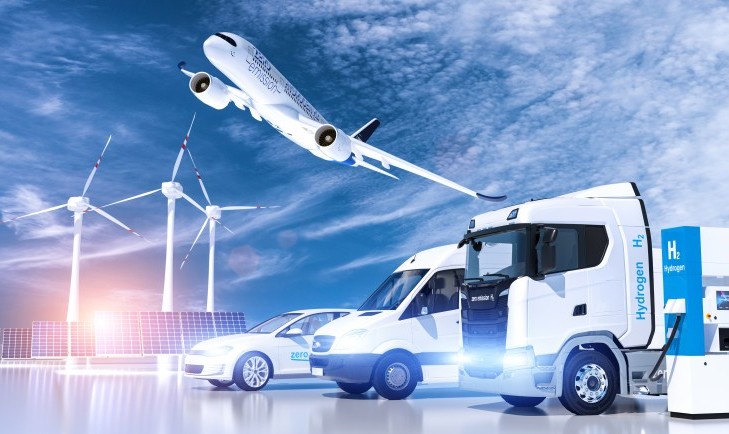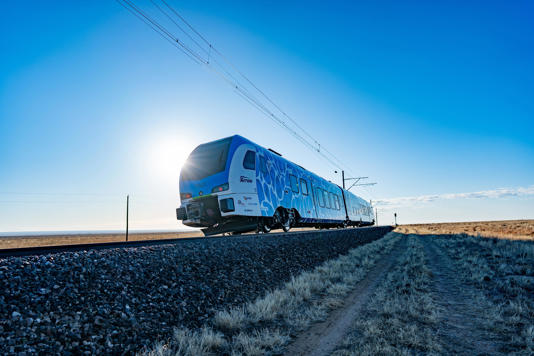04/04/24
Best of the West: Advancing hydrogen; A geothermal tax credit in Colorado; The world’s largest carbon capture plant; The surprising recovery of bees; and Improving financial literacy in North Dakota

The Western Governors' Association keeps you updated on the latest news in the West. Here are the top stories for the week starting April 1, 2024. (Photos courtesy of AA+W, Stadler U.S. Inc, and Lost_in_the_Midwest).
Clean hydrogen has the potential to be a low- or zero-emission alternative to fossil fuels that could greatly reduce the emissions from transportation, but it’s not yet economical to produce. Recent advancements in hydrogen production, however, have spurred companies to ramp up the development of hydrogen powered vehicles.
The federal government recently awarded $750 million for 52 projects across 24 states aimed at reducing the cost of clean hydrogen and increasing the available supply by developing more advanced electrolyzers and hydrogen fuel cells.
Other entities are looking at less traditional forms of hydrogen production.
While it has long been geological dogma that there are no significant underground pools of hydrogen gas, a sizable reservoir of hydrogen gas discovered in Mali, Africa, has changed that belief and, in recent years, the Front Range of Colorado has become a hot spot in the search for geologic hydrogen gas.
“Geologic hydrogen has massive potential,” said Mengli Zhang, a geophysicist at the Colorado School of Mines. “The geologic hydrogen gold rush is coming.”
Researchers at the University of Texas at Austin and the University of Wyoming’s School of Energy Resources are also exploring a suite of natural catalysts to help produce hydrogen gas from iron-rich rocks without emitting carbon dioxide. “We’re producing hydrogen from rocks,” said Toti Larson, a research associate professor at the UT Jackson School of Geosciences Bureau of Economic Geology and the lead researcher on the project. “It’s a type of non-fossil fuel production of hydrogen from iron-rich rocks that has never been attempted at an industrial scale.”
Researchers at the Lawrence Livermore National Laboratory have partnered with Los Angeles-based SoCalGas and Munich, Germany-based Electrochaea to develop an electro-bioreactor that allows excess renewable electricity from wind and solar sources to be stored in chemical bonds as renewable natural gas and used to create hydrogen.
As advancements are made, markets are responding by ramping up applications for hydrogen.
Electric Hydrogen, a start-up backed by Bill Gates, secured an agreement with AES to buy 1GW of its electrolysis systems — the second gigawatt-scale deal signed by the company in under six months.
 Stadler, a Swiss company with U.S. headquarters in Salt Lake City, recently set a Guinness World Record when its hydrogen-powered FLIRT H2 passenger train traveled 1,741.7 miles on a single tank filling. When it goes into service at the end of 2024, the FLIRT H2 will be the first hydrogen-powered passenger train in the U.S. and travel along the San Bernardino County Transportation Authority's 9-mile route between the city of San Bernardino and the University of Redlands in California.
Stadler, a Swiss company with U.S. headquarters in Salt Lake City, recently set a Guinness World Record when its hydrogen-powered FLIRT H2 passenger train traveled 1,741.7 miles on a single tank filling. When it goes into service at the end of 2024, the FLIRT H2 will be the first hydrogen-powered passenger train in the U.S. and travel along the San Bernardino County Transportation Authority's 9-mile route between the city of San Bernardino and the University of Redlands in California.
With hopes of decarbonizing freight, Denver, Colorado-based Nikola opened its first hydrogen refueling station, located in Ontario, Canada, which can be used by heavy-duty hydrogen fuel-cell trucks. The use of liquid hydrogen solves a couple of problems that can plague the gaseous hydrogen stations, by consuming only a tenth the space that gaseous hydrogen does, allowing it to refill about 20 to 25 trucks per day. The extremely cold nature of liquid hydrogen (-423 Fahrenheit) also eliminates the overheating issues that can hamper gaseous hydrogen delivery.
Geothermal Tax Credit: Following Colorado Governor Jared Polis’ WGA Chair initiative, The Heat Beneath Our Feet, the Colorado Energy Office announced its first competitive application cycle for the state’s Geothermal Electricity Tax Credit Offering (GETCO) – one of the nation’s first state tax incentives for geothermal electricity investment and production.
“Geothermal energy means lower costs on Coloradans’ energy bills and cleaner air. By breaking down barriers to this clean renewable energy resource, Colorado can move even closer to our goal of 100% renewable energy while saving people money on energy, improving reliability, and protecting our air quality,” said Governor Jared Polis.
Learn more about policy reforms to accelerate the deployment of geothermal energy systems by reading the Heat Beneath Our Feet initiative report.
World’s Largest Carbon Capture Plant: Membrane Technology and Research Inc. (MTR) and the Wyoming Carbon Storage Assurance Facility Enterprise — also known as CarbonSAFE, was awarded $4.6 million from the U.S. Department of Energy to continue a carbon capture pilot project at the Dry Fork Station in Gillette, Wyoming (a coal-fired powerplant). Using proprietary membranes that separate carbon from the fumes emitted from Dry Fork, when it becomes operational later in 2024, MTR plans to capture more than 150 tons of carbon dioxide each day, making it the largest capture plant based on clean membrane technology in the world.
Learn more about carbon capture membranes by watching the Decarbonizing the West initiative workshop in Gillette.
 Bee Recovery: According to the new Census of Agriculture, America’s honeybee population has surprisingly risen to an all-time high. According to the census, there are now 3.8 million bee colonies across the county, almost a million more than were reported five years ago. Since 2007, the first census after alarming bee die-offs began in 2006, the honeybee has been the fastest-growing livestock segment in the country, and that doesn’t count feral honeybees, which may outnumber their captive cousins several times over.
Bee Recovery: According to the new Census of Agriculture, America’s honeybee population has surprisingly risen to an all-time high. According to the census, there are now 3.8 million bee colonies across the county, almost a million more than were reported five years ago. Since 2007, the first census after alarming bee die-offs began in 2006, the honeybee has been the fastest-growing livestock segment in the country, and that doesn’t count feral honeybees, which may outnumber their captive cousins several times over.
Financial Literacy: North Dakota Governor Doug Burgum was joined by the leaders of 11 state agencies to kick off Financial Literacy Month by announcing the launch of SmartwithMyMoney.nd.gov, a free website designed to improve financial literacy by allowing users to take a research-based financial personality assessment and learn how their personality affects their money decisions. That information, when paired with their level of financial knowledge on key topics, identifies personalized learning resources on the site to improve financial literacy. Completing challenges on the site enters people in a pool for a chance to win cash prizes.
“When residents are financially healthy, there are far-reaching positive impacts on their personal well-being and the state’s economy,” Governor Burgum said.
.png) King of the Hill: Colorado basketball legend Chauncey Billups, also known as Mr. Big Shot or King of the Hill, is set to be elected to the Naismith Basketball Hall of Fame. Billups, the third overall pick in the 1997 NBA draft following All-American careers at George Washington High School and the University of Colorado, went on to enjoy a 17-year career during which he was a five-time All-Star, three-time All-NBA selection and two-time selection to the all-defensive team. Billups also helped lead the Nuggets to the Western Conference finals in 2009 and was selected as the final MVP in 2004 after leading the Pistons to an NBA Championship over the legendary Kobe and Shaq-led LA Lakers in just five games.
King of the Hill: Colorado basketball legend Chauncey Billups, also known as Mr. Big Shot or King of the Hill, is set to be elected to the Naismith Basketball Hall of Fame. Billups, the third overall pick in the 1997 NBA draft following All-American careers at George Washington High School and the University of Colorado, went on to enjoy a 17-year career during which he was a five-time All-Star, three-time All-NBA selection and two-time selection to the all-defensive team. Billups also helped lead the Nuggets to the Western Conference finals in 2009 and was selected as the final MVP in 2004 after leading the Pistons to an NBA Championship over the legendary Kobe and Shaq-led LA Lakers in just five games.